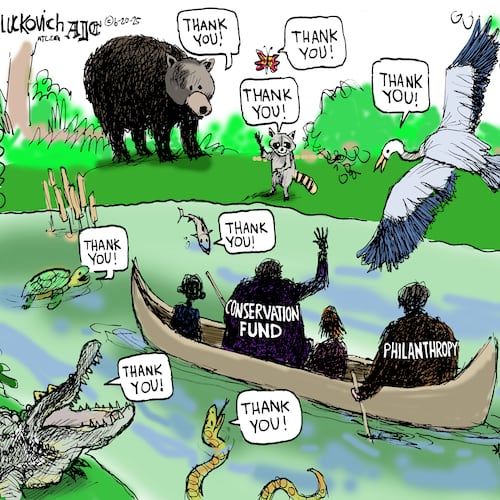On June 20, it was announced Twin Pines Minerals had finally agreed to give up its dangerous mining plan along the edge of the Okefenokee Swamp.
This incredible news came after six years of dogged work by untold numbers of people from all around Georgia and beyond — students, scientists, rabbis, preachers, lawyers, teachers, legislators, columnists, retirees and more — who spoke out incessantly against the project and the mining company and for the swamp.
It was a reminder that natural and cultural treasures like the Okefenokee transcend politics, race and geography and have the unique power to unite us in a time when very little does.
It was also an example of the importance of using information to hold our corporations, elected officials and regulators accountable for their actions.
Our organization was honored to have played a major role in all of it. The Twin Pines saga also showcased the continuing power of money and influence in the decision-making of our elected officials.
Leaders such as Kemp, Jones and Burns should have acted sooner
Credit: Georgians for the Okefenokee
Credit: Georgians for the Okefenokee
Publicly available data showed the company had spent hundreds of thousands of dollars in campaign contributions and lobbying to secure the support of Gov. Brian Kemp, Lt. Gov. Burt Jones, Speaker Jon Burns and others.
In light of this, we should ask ourselves the questions: Why did the project survive as long as it did despite scores of independent scientists saying it would damage the swamp? Why didn’t Kemp lift a finger or say a word publicly about Twin Pines or the project since being elected over six years ago, despite hundreds of thousands of comments against the project and personal pleas for his involvement? Why did Burns deny votes on the Okefenokee Protection Act for three years in a row despite it having overwhelming bipartisan support, and why did Jones fail to allow a vote on a mining moratorium bill in 2024?”
But when our leaders wouldn’t act, the people did, overwhelmingly, and for the second time in the past 30 years overcame seemingly impossible odds to save the swamp. In the late 1990s, I was honored to help lead a team that successfully convinced DuPont, the world’s largest chemical company, to abandon plans for a massive strip mine along the entire eastern boundary of the Okefenokee.
Then as now, we mobilized an incredible diversity of voices to speak out against the project and win the day. After becoming a lawyer, I had the privilege of representing The Conservation Fund in accepting the donation of DuPont’s land, a portion of which we then transferred to the Okefenokee National Wildlife Refuge. That was the culmination of six years of work, and I never thought I would get to feel that thrill again, or have to once again fight to protect this incredible place.
I was wrong on both counts.
Other parts remain unprotected
Credit: HYOSUB SHIN / AJC
Credit: HYOSUB SHIN / AJC
While the end of the Twin Pines threat is tremendous news, we cannot celebrate just yet, as there is still much work to be done. Thousands of acres of other land along the swamp’s edge immediately north of the Twin Pines tract, which is owned by a timber company called Toledo Manufacturing, remains unprotected.
Toledo leased its land to DuPont in the 1990s, and its owner, Joe Hopkins, is on record saying he wants DuPont’s corporate successor, Chemours, to mine on its land today. That would explain why Chemours has for three years rejected requests by shareholders, faith leaders, students and conservationists to make permanent its temporary pledge to avoid mining at the Okefenokee.
And public records show that Toledo and Chemours have collectively donated nearly $50,000 to Kemp, so they could still have his ear.
The question now is what will these players do? Will Kemp redeem himself and follow the lead of the scientists and citizens who have overwhelmingly urged him to protect the swamp, or instead support his two wealthy donors seeking to become even richer?
Will Chemours declare publicly it will permanently avoid having anything to do with mining at the swamp, or will it continue to duck the issue? It certainly could use an improvement in its public image, as it is the face of the forever chemicals mess that has contaminated drinking water systems from coast to coast, including in the city of Savannah, which is suing the company.
Will Joe Hopkins sell his land for conservation and create an enduring legacy for his company and family, or will he continue his 30-year quest for a massive payday despite already being one of the wealthiest men in south Georgia?
And will the legislature finally honor the will of the public and pass the Okefenokee Protection Act?
With UNESCO currently considering making the Oke a World Heritage Site, and with mining posing a threat to that achievement, the stakes couldn’t be any higher. All of us who love the Okefenokee must be the ones who dictate these answers, not already wealthy companies seeking to get rich from minerals used for whitening toothpaste and Oreo cookie filling.
The Okefenokee is one of the world’s greatest treasures, and we owe it to our children and grandchildren to not stop until we’ve secured its permanent protection. Let’s get back to work.
Josh Marks is an environmental attorney in Atlanta and president of Georgians for the Okefenokee, a statewide group focused on protecting the Okefenokee Swamp from mining.
About the Author
Keep Reading
The Latest
Featured





